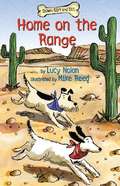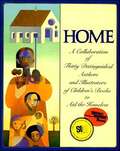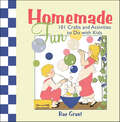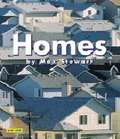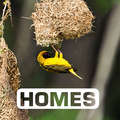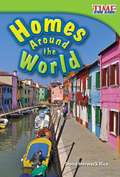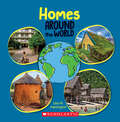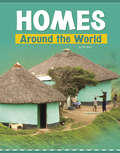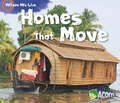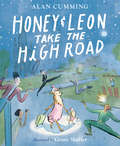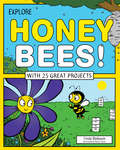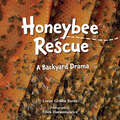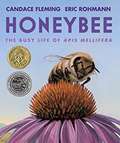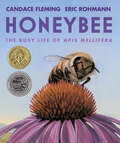- Table View
- List View
Home on the Range (Down Girl and Sit #4)
by Lucy NolanTwo dogs named Down Girl and Sit go out west with their owners and meet barking squirrels (prairie dogs), ugly dogs (coyotes), and a gasoline-powered bull (a truck). Told from a canine point of view, this fourth book in the Down Girl and Sit chapter book series by Texas Bluebonnet Award winner Lucy Nolan is filled with humor.
Home, Home
by Sibu T. P.A debut picture book that is filled with beautiful and lush illustrations, about the duality of home and living between two cultures.Summer has arrived and Ajesh is ready to spend the next few months in the comfort of his bedroom, drinking the chaiya that his mom makes specially for him. Ajesh feels most at home when he is drinking the warm, milky tea that is like the color of his skin with his parents, and away from the outside world that often makes him feel like he's different.But when his parents announce that they're going on a trip "back home"--to Kerala, India--he has trouble connecting with a place that is so unfamiliar to him. The sticky heat, crowded streets, and swaths of family members who seem to know his name, even though they've never met, make him long for the life and physical spaces that he's used to--that is, until chaiya is served. Home, Home is a beautiful debut picture book about the duality of home, connecting with your ancestral lands, and the daily rituals that ground and link us across space and generations.
Home: A Collaboration of Thirty Distinguished Authors and Illustrators of Children's Books to Aid the Homeless
by Michael J. RosenIn this very special anthology of beautifully poetic short stories, thirty distinguished authors and illustrators explore the unique and varied meanings of home. Their touching words and magnificent art affirm the importance—and joy—of having a place to call one’s own.Culturally diverse, multi-representative, and socially inclusive, this book is nourishment for the young soul.At a time when displacement and homelessness remain painfully present in our society, this classic anthology is indispensable. The distinguished contributors to this collection include:Franz BrandenbergMimi BrodskyLucille CliftonVirginia HamiltonJamake HighwaterKarla KuskinMyra Cohn LivingstonLiz RosenbergCynthia RylantJon ScieszkaLaurence YepJane YolenArthur YorinksAlikiKaren BarbourPat CummingsLisa DesiminiLeo and Diane DillonRichard EgielskiSheila HamanakaJames MarshallJerry PinkneyVladimir RadunskyJames RansomeAminah RobinsonMarc SimontLane SmithMary SzilagyiVera B. WilliamsHome can be. . .playing on the stoop of your building,sitting in your grandmother’s kitchen,or hiding under your back porch stairs.
HomeWork Hassles: Simple tips and strategies to reduce frustration
by Pam GoodmanYou'll decrease everyone's frustration levels with this powerful go-to guide. Educate yourself with proven, easy to apply tips and strategies that empower young children to become independent with homework and embrace the love of learning. This guide is packed with knowledge gathered from over 14 years of hands-on experience with children. By adopting Pam Goodman's strategies, you'll enjoy watching your child blossom into a confident, successful, and independent student. Who knows--you both might end up liking homework!
Homemade Fun: 101 Crafts and Activities to Do with Kids
by Rae GrantHomemade Fun is Rae Grant's third charming family activity book. Like the previous books in the series, Homemade Fun offers a generous collection of classic activities for kids and families who enjoy making creative projects at home, paired with delightful vintage art throughout. Parents, especially moms who are juggling kids, time, and a budget, can use this book as a resource when looking for ways to enrich and entertain their kids. Featuring a versatile compilation of classic crafts, games, and activities that are family and kid-oriented, the book can be used for many different situations including camp activities, after-school activities, birthday parties, rainy day events, and vacations as well. Homemade Fun will provide hours of family fun!--stitch a handy wallet--build a tool box--decorate a pillowcase--make paper flowers--bake pretzels--decorate cupcakes--have a pizza party--hold a bubble raceplus so much more!
Homes (Fountas & Pinnell LLI Green #Level C, Lesson 37)
by Nancy LingFountas and Pinnell Leveled Literacy Intervention Green System -- 1st Grade
Homes (Picture This)
by Judith NouvionHomes are everywhere in nature. Discover many different kinds in these eye-catching photographs of animals in their natural habitats. From the silk thread spun by the weaver ant to the snowy den dug out by the polar bear, children will learn about where animals live and how they build or find their dwellings in our natural world. Perfect for very new and curious learners!
Homes Around The World (Time For Kids® Nonfiction Readers Ser.)
by Dona Herweck RiceLearn about the different places that people call home--from apartments to cottages and castles to farmhouses. With bright, vivid photos and easy-to-read informational text, readers are introduced to different cultures' definitions of "home."
Homes Around the World (Around the World)
by Lisa M. HerringtonDiscover countries, cultures, and traditions in this new series!Every day, all around the world, kids go to school, eat lunch and play games... And yet, these universal experiences, can look very different between different countries. These books will take our readers on a trip around the globe to celebrate diverse cultures and traditions, and will show us how different (and how similar) we all are!
Homes Around the World (Customs Around the World)
by Wil MaraWhat is your home like? Is it big or small? Is it made of concrete, straw, wood, or clay? Step inside homes from around world and see how different people live in this engaging series that develops kids' understanding of our diverse global community and their place in it.
Homes That Move (Where We Live Ser.)
by Sian SmithThis book takes a simple look at homes that move, highlighting the diversity of homes that people live in around the world. Homes featured include Native American Tipis, Bedouin tents, houseboats, caravans, and more. Throughout the book, simple leveled text supports bright and engaging photographs, and the book also includes a picture glossary of difficult and important words, and notes for parents and teachers with advice on how to use the book.
Homes in Many Cultures (Life Around The World Ser.)
by Heather AdamsonStep inside homes all over the world. What makes them the same as yours? What makes them different?
Homespun Sarah
by Verla KaySarah's life in Colonial Pennsylvania is anything but easy. She and her family have to grow, raise, and make everything they need-including their clothes. The time and effort that takes means that nothing is replaced until it's absolutely necessary. As Sarah helps plant flax and raise sheep throughout the year, her one dress gets tighter and tighter. But in the nick of time, wool is spun, fabric is woven, and a brand-new dress is made just for her.
Honey & Leon Take the High Road
by Alan CummingAlan Cumming and Grant Shaffer's world-traveling dogs are back...and off to Scotland! When Honey falls in love with a handsome Scottish pup, will Leon be able to protect their dads on his own?Honey and Leon have done a very good job of keeping their dads safe--but now the dads have decided to travel again! So the two loyal dogs pack up their disguises and secretly follow them all the way to Europe on a Scottish Highland adventure. All is going according to plan...until Honey becomes besotted with a charming Scottish dog named Coll! Can Leon manage to keep their dads out of trouble on his own while Honey is gallivanting with her new beau? Actor Alan Cumming and artist Grant Shaffer bring to life the imagined secret identities of the two dogs they once owned. Hilarious, sassy dialogue and wild escapades make this an unmissable read-aloud, perfect for families who love to put on a show!
Honey Bees!
by Cindy BlobaumWhat did you have for breakfast this morning? Toast, cereal, juice, and fruit? Thank the honey bees! About one out of every three mouthfuls we eat is affected by honey bee pollination. In Explore Honey Bees! With 25 Great Projects, young readers learn about honey bee colonies, why honey bees live in hives, how honey bees communicate with each other, and why they are so important to human lives. Colony collapse disorder first appeared in 2006 and since then beekeepers have seen disappearances of 30 to 90 percent of their bee colonies each year. Readers learn about possible reasons behind and solutions to this growing global problem. Explore Honey Bees! offers a glimpse into a miniature world familiar to children. Activities include designing a hive and making a model of a flower’s reproductive system, reinforcing the math and science skills readers gain from the text. Fun facts and colorful illustrations make learning fun and exciting. Links to online primary sources integrate a digital learning experience and offer opportunities to delve deeper into the world of honey bees. This title meets Common Core State Standards in language arts, science and technology; Guided Reading Levels and Lexile measurements indicate grade level and text complexity.
Honey For Baby Bear (Rigby PM Platinum #Blue (Level 9-11))
by Beverley Randell Isabel LoweBaby Bear goes into the forest to look for honey, and can't find his way home.
Honey... Honey... Lion!
by Jan BrettThe African plains provide a stunning environment for Jan Brett's latest animal adventure. For as long as anyone can remember, the honeyguide bird and the African honey badger have been partners when it comes to honey:Honeyguide finds the honeycomb, Badger breaks it open, and they share the sweetness inside.But this day, Badger keeps all the honey for himself. Foolish Badger!In no time, Honeyguide leads Badger on a fast chase. Badger thinks it's for honey; but Honeyguide has a surprise waiting for her greedy friend.As they swim across a pond, push through a thicket of reeds, leap over a huge anthill, a menagerie of exotic animals passes the news along in a kind of animal Bush Telegraph. Finally Badger faces a lift-the-flap page, revealing the twist that teaches Badger a lesson. Can you guess who's under that flap?Honey . . . Honey . . . Lion! will surely become a family favorite for readers of all ages.
Honeybee Rescue: A Backyard Drama
by Loree BurnsFans of the Scientists in the Field series will love discovering ways to save and protect bees through the eyes of a honeybee rescuer. Follow honeybee rescuer Mr. Nelson as he expertly removes a colony of bees from Mr. Connery's barn (with a vacuum!) and helps it relocate back to a hive. Photographs of Mr.Nelson’s relocation of the colony help bring the honeybee rescue to life. <P><P> Nature lovers and scientists-to-be will be abuzz as they learn all the ways to keep honeybees (and our ecosystem) safe. <P><P><i>Advisory: Bookshare has learned that this book offers only partial accessibility. We have kept it in the collection because it is useful for some of our members. Benetech is actively working on projects to improve accessibility issues such as these.</i>
Honeybee The Busy Life of Apis Mellifera: The Busy Life Of Apis Mellifera
by Candace FlemingThe life cycle of a honeybee is explained in this book.
Honeybee: The Busy Life of Apis Mellifera
by Candace FlemingRobert F. Sibert Medal Winner Take to the sky with Apis, one honeybee, as she embarks on her journey through life!An Orbis Pictus Honor BookSelected for the Texas Bluebonnnet Master ListFinalist for the AAAS/Subaru SB&F Prize for Excellence in Science Books A tiny honeybee emerges through the wax cap of her cell. Driven to protect and take care of her hive, she cleans the nursery and feeds the larvae and the queen. But is she strong enough to fly? Not yet! Apis builds wax comb to store honey, and transfers pollen from other bees into the storage. She defends the hive from invaders. And finally, she begins her new life as an adventurer. The confining walls of the hive fall away as Apis takes to the air, finally free, in a brilliant double-gatefold illustration where the clear blue sky is full of promise-- and the wings of dozens of honeybees, heading out in search of nectar to bring back to the hive. Eric Rohmann's exquisitely detailed illustrations bring the great outdoors into your hands in this poetically written tribute to the hardworking honeybee. Award-winning author Candace Fleming describes the life cycle of the honeybee in accessible, beautiful language. Similar in form and concept to the Sibert and Orbis Pictus award book Giant Squid, Honeybee also features a stunning gatefold and an essay on the plight of honeybees.Cook Prize Honor BookA Kids' Book Choice Award FinalistAn American Library Association Notable Children&’s BookA New York Public Library Best Book of the YearNamed a Best Book of the Year by Kirkus Reviews, NPR, Shelf Awareness, School Library Journal, Publishers Weekly and more!A Horn Book Fanfare Best Book of the YearA Bank Street Best Children's Book of the Year!A Bulletin of the Center for Children's Books Blue Ribbon BookA Booklist Editor's ChoiceNamed to the Texas Topaz Reading ListA Junior Library Guild Gold Standard Selection
Honeybees (All About Science Reader, Station Stop #2)
by Joyce Milton Peter R. Mueller Pete MuellerBzzz! Learn all about the life cycle of honeybees, how they make honey, and more. With fun bee facts and bright, realistic artwork, this Station Stop 2 easy reader will fly off bookshelves! I
Honeybees (Little Critters Ser.)
by Lisa J. AmstutzHoneybees buzz from flower to flower. Everything they do helps the hive. Appeal to young children’s fascination with nature with delightfully simple, fun text, and bright, close-up photos. All Little Pebble books have an Accelerated Reader ATOS level of 1.0 or below.
Honeybees (Penguin Young Readers, Level 3)
by Joyce MiltonBzzz! Learn all about the life cycle of honeybees, how they make honey, and more. With fun bee facts and bright, realistic artwork, this Station Stop 2 easy reader will fly off bookshelves!Illustrated by Pete Mueller.
